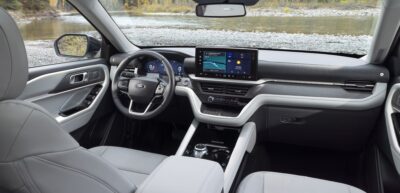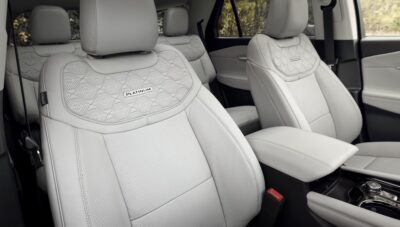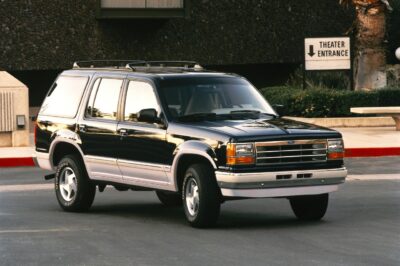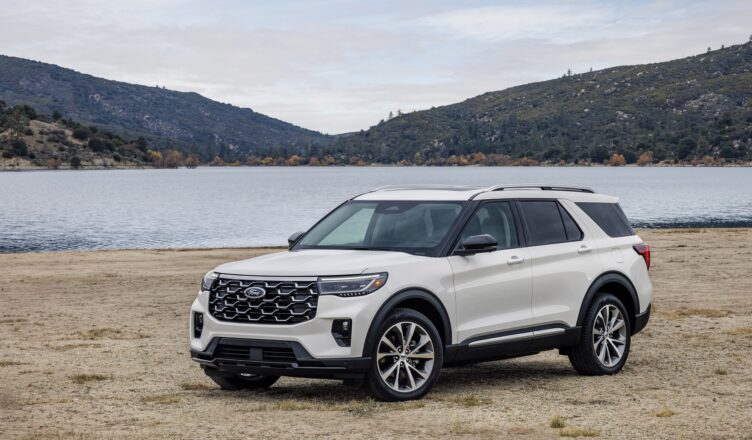The Ford Explorer has been a lot of things to a lot of people. It started out as an extended Bronco II that was based on the Ford Ranger pickup. By the early 2000s, it grew and gained an independent rear suspension – a big deal at the time. Its next generation grew more and adopted the Volvo XC90’s architecture that gave families a big safety hug. None of those would be considered a performance-oriented luxury crossover like the 2025 Ford Explorer Platinum we have here.
Explorer is America’s all-time best-selling SUV brand, and despite all of the changes, you could park the current one next to the original and know they are evolutions of the same. Yet, designers finessed it for 2025 with a larger grille, sleeker headlamps, front skid plate, and LED taillamps that extend across the hatch nameplate. Platinum editions wear a satin chrome and ebony face plus 21-inch dark alloy wheels. Deep body sculpting hints at the performance within.
Platinum interiors are more Lincoln than Ford with diamond-stitched leather, wrap-and-stitch soft-touch surfaces and sliver mesh accents. Luxuriate further with a heated steering wheel and heated seats front/rear. Front seats are also ventilated in summer. A power steering column, crisp B&O audio, and panoramic roof add a veneer of luxury. I really like the tweedy fabric on the dash and doors. Third-row seats power fold to expand cargo capacity, but they’re better suited for kids than adults. It’s all very lush, but also stocked with technology.
Previous Explorer owners might notice flatscreen gauges and a larger touchscreen this year. Phones connect wirelessly via Apple CarPlay and Android Auto. Charge them wirelessly too. Google Assistant now serves as the default voice assistant if you require such a thing. Stream videos and play games via the web, YouTube, Prime Video, and Vivaldi. Owners can use their phone as a key, drive hands-off on highways with BlueCruise, and stay safe with lane keep assist, blind spot warning, automatic emergency braking, and reverse auto brake systems.
We’ve come a long way since the original Explorer debuted for 1991.
What you don’t immediately notice is the rear-drive based architecture underpinning this fashion show. Shifting power focus from fore to aft allows a significantly more athletic and crisp driving experience. It’s still a big three-row crossover better suited for cross-country drives than track days, but it seems a better dance partner in the driver’s hands. But don’t worry about winter weather or light off-roading because our fly ride comes with all-wheel-drive that handled a recent snow storm with ease. Get in and go without worry.
Base models come with a 2.3-liter turbo-four engine producing 300 horsepower, and that’s plenty to move a three-row crossover with aplomb, but we didn’t go for that little wheezer. Instead, our Platinum edition stepped up with a 3.0-liter twin-turbo V6 delivering a vigorous 400 horsepower and 415 lb.-ft. of torque. It wasn’t long ago that world-class supercars barely enjoyed that much power. All of it gets to the road through a 10-speed automatic transmission and electronic all-wheel-drive. Fuel economy rated 18/24-MPG city/highway isn’t bad, but having a hybrid option would be even better.
As you might expect, the Explorer Platinum comes with a luxury price, but maybe not as luxurious as you imagine. A base Explorer starts at a reasonable $39,755, but our top-trim model with turbo V6 and hands-off driving comes to a loftier $61,155. That compares favorably with key rivals like the Chevy Traverse, Jeep Grand Cherokee, Mazda CX-90, Toyota Highlander, Kia Telluride and Hyundai Palisade.
Storm Forward!
Send comments to Casey at AutoCasey@aol.com; follow him on YouTube @AutoCasey.
